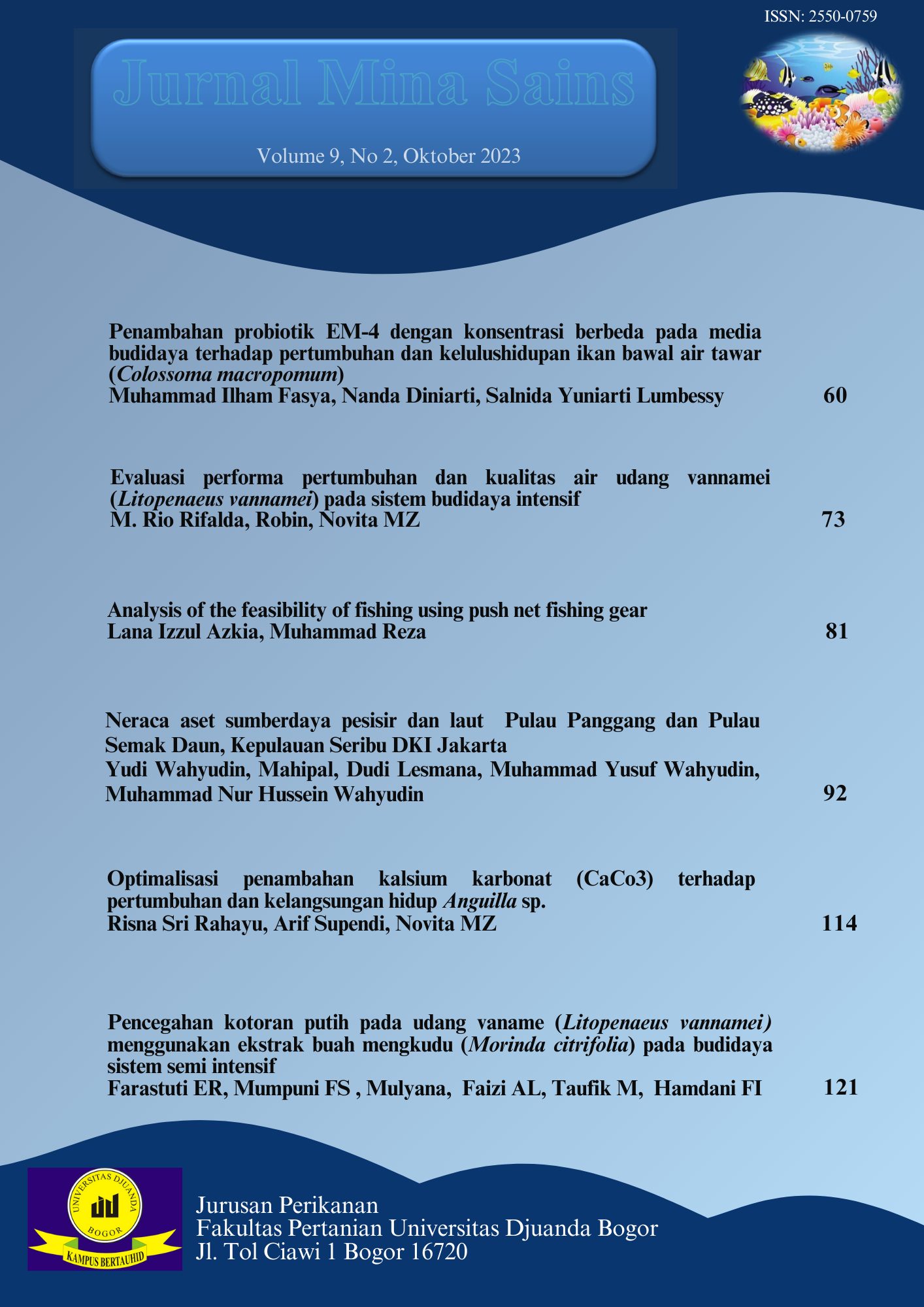Prevention of white impurities in vaname shrimp (Litopenaeus vannamei) using noni fruit extract (Morinda citrifolia) in semi-intensive shrimp cultivation system
Main Article Content
Abstract
White vanamae shrimp is one of the superior commodities in aquaculture. Currently, the productivity of white vanamae shrimp has not yet reached its production target. So, it is necessary to increase the amount of production on a gradual scale carried out by the community. In shrimp farming activities, disease problems are often encountered. Namely is a white stool, white feces, or White Feces Disease (WFD). The clinical symptoms that arise when shrimp are attacked by White Feces Disease (WFD) are that the shrimp's appetite decreases, the shrimp's intestines change color to white and even look empty due to lack of food intake, white feces floating on the surface of the water, and the shrimp's growth becomes abnormal. This WFD disease can be caused by poor cultivation practices, unhealthy seeds, and poor water quality, causing the emergence of disease microorganisms such as Vibrio sp bacteria. One way to treat this disease is to provide alternative medicine, noni fruit extract. This research consisted of 3 noni extract treatments and consisted of 3 replications, namely Treatment A: 10 mL/L; Treatment B: 15 mL/L; Treatment C: 20 mL/L. The noni dose is given at the specified dose once daily for one month. The survival rate of shrimp increased to 86.7%.
Article Details

This work is licensed under a Creative Commons Attribution-ShareAlike 4.0 International License.
With the receipt of the article by the Jurnal Mina Sains Universitas Djuanda Editorial Board and the decision to be published, then the copyright regarding the article will be diverted to Jurnal Mina Sains Universitas Djuanda.
Department of Fisheries Djuanda University holds the copyright regarding all the published articles in this journal.
Department of Fisheries Faculty of Agriculture, Universitas Djuanda has the right to multiply and distribute the article. Thanks to the Fisheries Department and Agriculture Faculty Universitas Djuanda that funded this journal sustainability.
The manuscript's authentic and copyright statement submission can be downloaded on this form.
References
Ayuza E (2008). Mekanisme penghambatan bakteri probiotik terhadap pertumbuhan Vibrio harveyi pada larva udang windu (Penaeus monodon). Sekolah pascasarjana IPB. Bogor. [tesis].
Effendie. 1997. Biologi Perikanan. Yayasan Pustaka Nusatama: Yogyakarta
Febrianti, A., Miftachurrochmah, A., Jannah, A. W., Muliawan, Y., & Sabil, A. A. (2019). Water Quality Controller for Cultivation of Vannamei Shrimp (Litopenaeus vannamei) in Wedoro Village, Glagah District, Lamongan Regency. Journal of Innovation and Applied Technology. (1):848-854.
Gultom, D.M., 2003. Patogenisitas Bakteri Vibrio Harveyi Pada Larva Udang Windu (Panaeus monodon Fabr.). Bogor: Institut Pertanian Bogor.
Haryanto. 2010. ”Analisis Kualitas Air Semur Dengan Parameter Cl Dan CaCo3”, Tugas Akhir Universitas Muhammadiyah Yogyakarta, Yogyakarta.
Helda, Y., Harpeni, E., & Supono. (2018). Aplikasi ekstrak daun ketapang (Terminalia catappa L.) terhadap udang vaname (Litopenaeus vannamei) yang terinfeksi penyakit white feces disease 9WFD). Jurnal Sains teknologi Akuakultur. 2(2)
Husni, E., Aisyah, S., & Uzra, M. (2023). Analysis of the socio-economic impact of the vannamei shrimp (Litoanaeus vannamei) fishery business activities on local communities in padang pariaman regency. analysis of the socio-economic impact of the vannamei shrimp (Litoanaeus vannamei) fishery business activities on local communities in Padang Pariaman Regency. International Journal of Progressive Science and Technology. 38(2): 245-251.
Izwar, A., Ayuzar, A., & Muliani. (2015). Pengaruh tepung buah mengkudu pada dosis yang berbeda untuk pengendalian bakteri Vibrio harveyi pada post larva udang windu (Penaeus monodon). Acta Aquatica. 2(1): 60-65.
Jayadi, M., A. Prajitno & Maftuch. 2016. The identification of Vibrio spp. bacteria from Litopenaeus vannamei infected by white feces syndrome. International Journal of ChemTech Research. 9 (7): 448-452 .
Landari, I. G. A. A. D., Kusumawati, I. G. A.. W., Nursini, N. W., & Yogeswara I. B. A. (2023). Profil senyawa flavonoid ekstrak buah mengkudu (morinda citrifolia L.) dengan berbagai metode pengeringan. Jurnal Teknologi Pertanian Andalas. 27(1): 1-10.
Lestantun, A., Anggoro, S., & yulianto, B. 2020. Peran Biosecurity dalam Pengendalian Penyakit pada Benih Udang Vanamei di Banten. Prosiding Seminar Nasional, Semarang 2 Desember 2020. Hal 53-58.
Marbun, J., Harpeni, E., & Wardyanto. (2019). Penanganan penyakit white feces pada udang vaname Litopenaeus vannamei menggunakan aplikasi pakan yang dicampur ekstrak lengkuas merah Alpinia purpurata k. Schum. Depik. 8(2): 76-86. DOI: 10.13170/depik.8.2.13570
Sarah, H., Prayitno, S. B., Haditomo, A. H., C, (2018). Studi kasus keberadaan penyakit IMNV (Infectious Myonecrosis Virus) pada udang vaname (Litopenaeus vannamei) di pertambakan pekalongan, Jawa Tengah. Jurnal Sains Akuakultur tropis. 2(1): 66-72
Sari C. Y. (2015). Penggunaan buah mengkudu (Morinda citrifolial) untuk menurunkan tekanan darah tinggi. J MAJORITY. 4(3):33-39
Se, A. N., Santoso, P., & Liufeto, F., C. (2023), Pengaruh Perbedaan Suhu dan Salinitas Terhadap Pertumbuhan Post Larva Udang Vaname (Litopenaeus vannamei). JVIP, 3(2): 84-89.
Sumini & Kusdarwati, R. (2020). Penemuan Vibrio harveyi pada Litopenaeus vannamei terinfeksi white feces Disease di Situbondo Jawa Timur. 22(1): 9-18. Jurnal perikanan. DOI 10.22146/jfs.47791
Wang, Y.G., M. Shariff, P. M. Sudha, P.S. Srinivasa, Rao, M. D. Hassan, & L.T. Tan. 1998. Managing white spot disease in shrimp, Infofish International. 30-36
Wijayakusuma, H, Setawan Dalimarta, Wirian. 1996. Tanaman Berkhasiat Obat di Indonesia. Jilid 4. Pustaka Kartini. Jakarta

